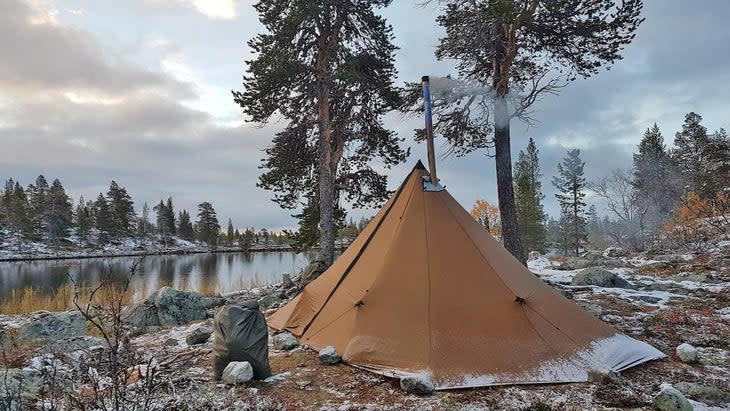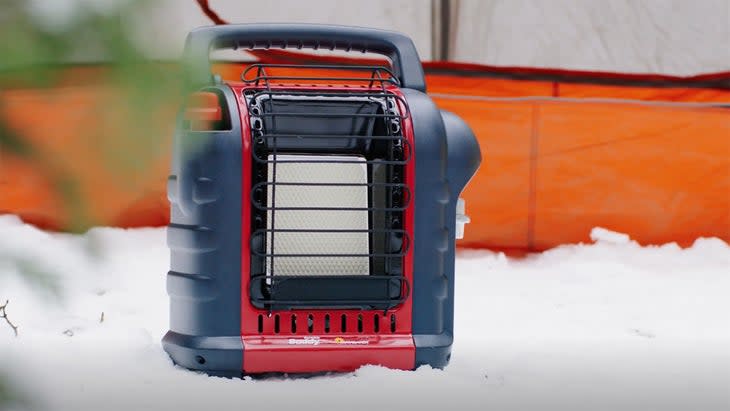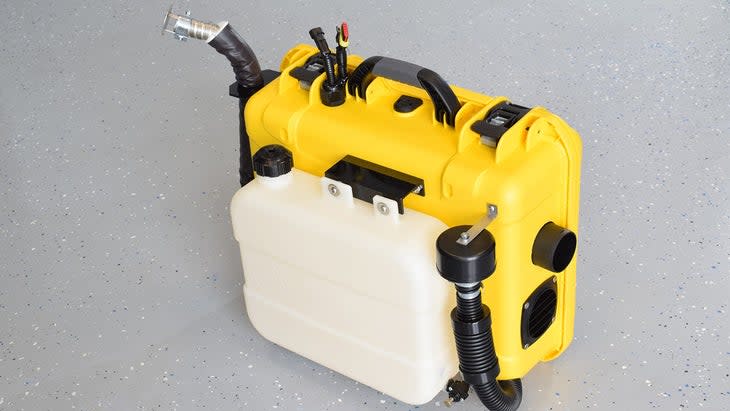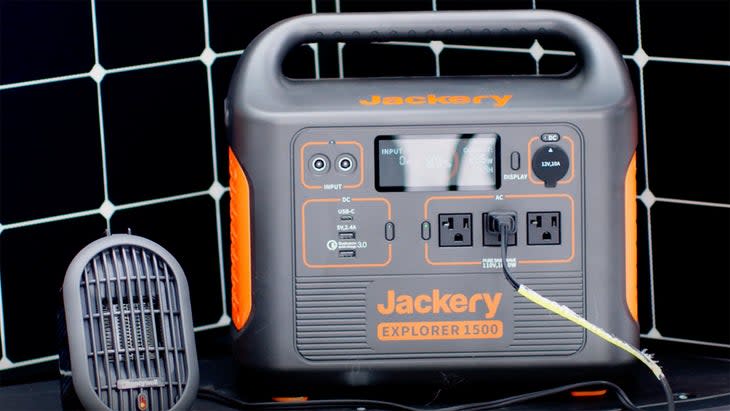How to (Safely) Heat a Tent
I want to be warm when it's cold out. That desire is simple, yet frustratingly elusive. In an effort to find a tent heater that wouldn't suffocate me in my sleep, set me on fire, max out the payload on my truck, or require immense amounts of labor and vast sums of cash, I spent the last two years trying every single solution available. It turns out that the simplest option turned out to be the best.
The Trouble with a Ultralight Wood Burner
The first solution I tried was the Seek Outside Redcliff Hot Tent, $1,355, a large, pyramid-shaped silnylon floorless shelter that comes complete with a wood-burning stove made from titanium . The Redcliff can comfortably sleep three adults if you've got the stove inside, and altogether weighs only about nine pounds. Split that up between all the sleepers and you've got a package light enough to carry into the backcountry, but with its six-foot, ten-inch peak, is tall enough to stand up inside and spacious enough to take car camping.

I first used the Redcliff in September of 2020, camping at an elevation just over 9,000 feet in Montana's Lee Metcalf Wilderness, outside of Yellowstone National Park. Like all tipi and pyramid shelters, it took a fair amount of trial and error to set up the first time. The hardest part to figure out was the chimney, which is made from almost foil-thin titanium. It rolls across its long side for storage, then when you wan to set it up, you have to flatten it, and roll it the other way to create a seven-and-a-half-foot tube with the aid of some wire loops. Gloves are mandatory, or it'll cut your hands to pieces.
The tent shape requires multiple stakes that surround the pyramid, which need to provide equal tension from all directions to keep the single carbon fiber center pole stable. Guyout points also wrap the tent, about halfway up, and using them is necessary to achieve the Redcliff's shape. Assembling every stake loop and guyout takes multiple adjustments, and is something you'll keep working on throughout any night (and the full duration of any trip) trying to chase a perfect degree of tension. You can get there, but until you do, expect material to flap in the wind, stakes to come out of the ground, and your level of frustration to remain elevated.
Using the Redcliff stove isn't straightforward either. A bow saw is critical, because it's crucial to find nice, dry wood that won't get too smokey, and then to cut it all into the right-size pieces. The correct diameter is about an inch. The correct length is about six inches. Any thinner, and it'll burn up too fast. Any thicker and it'll just smolder out. Any longer, and it won't fit. Not only is that a lot of labor up front (you'll need several arm fulls to get you through one cold night), but it remains a lot of labor throughout the night when you'd rather be sleeping. Get the stove running just right, load precisely the correct amount of wood into it, and the longest you can expect it to burn unattended is about half an hour. Once it goes out, titanium and silnylon retain very little heat. Restarting a dead fire involves making a whole new fire. That's not much fun at 3 A.M.
The Trouble with Propane
Frustrated, I gave up on the idea of bringing a heated shelter into the backcountry, and instead focused my efforts on car camping.
I first turned to a solution I knew was a bad idea, but which is used by so many people, I wanted to try it again, just to make sure I wasn't missing something. The advantage of propane is that it packs a ton of energy into a very dense, ubiquitous storage medium. That means you can use a propane heater to kick out a ton of heat for a long time, for not a lot of money. One of those one-pound bottles will run a 3,800 BTU Mr. Heater Little Buddy ($105) for about five hours. But I wanted to find a less wasteful solution. Since I already use a bracket from Power Tank ($130) to bolt a five-pound propane bottle to my spare tire to run my big stove, I figured I could go with the larger 9,000 BTU, Mr. Heater Buddy ($130), and connect it to the bottle with one of the brand's hoses and fuel filters. (Propane degrades rubber over time, adding complication to systems that use it.) The advantage wasn't just more heat, but getting to use a refillable bottle large enough to deliver multiple nights of use.

While the Buddy did heat my tent, the amount of heat it puts out is surprisingly limited. There's also no fan included to spread the heat out. So, unless you're sitting directly in front of the heating element, you'll be disappointed. The list of downsides of using propane as a heat source is also long and scary.
Open-flame heat sources start fires, which can kill you.
Burning propane produces carbon monoxide, which can kill you.
Because carbon monoxide can kill you, quality propane heaters include an oxygen sensor. If that's working, it'll turn off the heater anytime oxygen levels fall to a level roughly equivalent to about 7,000 feet in elevation. So, they won't run at elevations over about 7,000 feet. Or at least they shouldn’t.
If you don't want to die, you need to turn off your propane heater before you go to sleep.
Burning propane produces a ton of water vapor, which will saturate anything and everything inside your tent. Once you turn that heater off, you will sleep considerably colder than you would have if you hadn't run the heater. Hypothermia can kill you.
The amount of heat produced by the Buddy was disappointing, and I generally try to avoid dying, so I gave up on propane.
The Trouble with Diesel Heaters
Still, that energy density makes powering a heater with a liquid or gas fuel source sound like a smart idea. So, I tried a diesel heater; one that was built into a $50,000 camper Black Series loaned to me for the summer.
Diesel heaters work by combusting fuel to warm up a heating element. A fan then draws clean air from outside through a pipe, running it across that heating element, before blowing it out the other end. Because the heated air and diesel exhaust don't mix, this creates a safe, dry source of warm, forced air. And that sounds ideal for heating a small space.

The thing is, that while they probably won't kill you, diesel heaters come with their own list of downsides. The first is that you must carry an auxiliary source of diesel fuel, which if you don't drive a diesel-powered vehicle, can be a real pain. Diesel is oily and smelly, so you want to keep it away from your camping gear, and you want to make sure the heater's exhaust runs well away from your shelter. Diesel heaters also require an electric power source to start up and run their controller. Setting up one every time you use a tent involves a lot of wires and tubes. They work better permanently installed on a camper. But even then, the ratio of fuel-to-air must be carefully altered at different altitudes. Some really nice diesel heaters claim to work at altitudes of over 14,000 feet, if you tinker with them enough to get them running right. Most quit on you at about 8,000 feet. I never managed to get the heater in the Black Series tuned to the point it would run longer than 15 minutes at any elevation.
Quality portable diesel heaters start at about $1,700, weigh about 30 pounds, and pack into a mid-size Pelican case. You'll need to carry the fuel separately. That's a lot of money, and a lot of stuff to haul around. For a heater to work for me, I needed it to be simple and quick to setup and use.
The Lux Option: The SnowTrekker Basecamp
Simple and quick are probably the opposite of the words you'd choose to describe most canvas wall tents. But not those made by a tiny mom-and-pop company out of Wisconsin called SnowTrekker. The mom and pop is literal for them: Duane and Margot Lottig run the company and sew the tents while their son Jonah handles marketing and logistics. They make their tents from a proprietary seven-ounce cotton canvas that's less than half the weight of the fabrics used in other wall tents, and support that body with a lightweight Easton aluminum pole system that's closer to that of a backpacking tent than it is the non-collapsible frames typical of the space. The four-person Basecamp model ($2,000) they loaned me this fall weighs just 31 pounds, while the large wood-burning stove (steel this time) adds another $300 and 25 pounds. A unique guyout system means the only stakes you need connect via lines to the horizontal wall poles. That arrangement not only makes SnowTrekker's tents incredibly strong, but also fast to set up. The first time I tried it, after only briefly fast forwarding through a YouTube video, I was warming my hands inside over a roaring wood stove in less than 20 minutes.
Video loading...
The big benefit of cotton canvas is that it's breathable. So with the wood stove burning inside (this time, one big enough to sustain a real fire for hours), any moisture that enters the tent through the cold ground or your wet clothes is forced outwards by the heat, resulting in a warm, dry interior that's a ridiculously comfortable place to spend time. And you really can spend time in there, with a ridge height measuring eight-and-a-half feet and dimensions that can generously house four people, all on their own cots, all with their gear spread out to dry. You can cook a real meal on the big stove, bring your camp table and chairs inside, and enjoy a level of comfort I've never experienced in cold, wet weather before or since.
The SnowTrekker is, by quite some margin, the most comfortable winter tent I've tried. But at $2,300 it's expensive. Plus, it weighs 56 pounds when you figure in the stove, and since it packs into two large duffel bags, it just requires a level of dedication I'm not quite ready for. I will, one day, own one of these, but until then, I want to add comfort to a normal tent that's smaller, and easier to transport.
The Simple Option: Battery-Powered Heating Sources
Electricity isn't an obvious power source while camping. Outdoors, you don't typically have access to an outlet, and batteries have never managed to pack nearly as much energy into as dense, or as affordable, a storage medium as liquid or gas fuels. But as we're seeing with electric vehicles, that's changing. Would one of the new portable battery packs that are now being marketed to outdoorsy types be able to run a heated blanket, or even a portable space heater for an entire night? And, if so, could it recharge fast enough that you could keep using it on subsequent nights?
I started that experiment by researching electric blankets online. I was looking for a 12 volt, DC blanket--direct current is more efficient than alternating, but can't travel as far without losses--but the only viable solution appeared to be a mattress pad built for long-haul truckers. Write ups on it quickly led to a warning that the pad can't be folded, because doing so will break the wires inside, and create a fire hazard. It's designed to be permanently installed on the bunk in a truck's cab, not carted around on camping trips. The next best thing appeared to be 100 watt heated blankets designed for home use. The heating elements inside those are said to be able to bend and fold, and that current draw remains relatively efficient. So, I ordered a 100 Watt Serta AC blanket ($60) on Amazon.

I've been using a Jackery Explorer 500 portable battery ($500) for the last couple of years while car camping, and at the cabin. Its 500 Watt-hour capacity is plenty to run camp lights, charge phones, or keep a couple lamps on when power goes out at the cabin. But the math is simple and problematic: a 100 Watt blanket will completely run down the Explorer 500 in five hours.
The first problem I ran into wasn't run time though, but build quality. With the blanket plugged in, the display on the Jackery confirmed it was drawing around 100 Watts, but the blanket didn't heat up at all. Customer reviews confirmed that the problem was common. So, I splurged on a more expensive, better-reviewed blanket ($100) from Degrees of Comfort. Plugged in, with plenty of time to warm up, I thought I could detect it emitting some heat, but an amount so small that I could have been imagining it. I'd need to take it outside, in the cold, to see if it actually worked.
Around that same time, Jackery sent over its new Explorer 1500 Solar Generator package ($2,699) for me to check out. With three times the capacity of the 500 and higher discharge rates, it's designed to run longer and power bigger appliances. The package includes four 100 Watt solar panels and all of the associated hardware, which the brand says will charge the battery from zero to 80 percent in four hours of direct sunlight.
I plan to use the Explorer 1500 to keep the lights on and appliances running at the cabin, which experiences frequent, prolonged power outages in the winter due to its remote location. People who live in states with governments that spend more time trying to control women's bodies than they do making sure their infrastructure works--Texas--would benefit from a similar setup.

Those 1500 watt-hours of power gave me what I needed to run that 100 watt blanket all night, for two nights on a single charge. And so equipped, I also figured I'd go ahead and see if it could run a space heater, too.
Most room-size electric space heaters switch between modes that draw 750 or 1,500 watts. In a best-case scenario, that $2,699 solar generator will only run one of those for two hours. But tents are smaller than rooms. In fact, they're about the size of a cubicle, and they make space heaters just for those. So, I ordered a dinky little $26 cubicle heater that switches between 100 and 250 watts of draw. The Explorer 1500 has no problem running it, and its display tells you how long the battery will last while powering anything that's plugged into it. The heater's 250 watt setting was actually drawing 225 Watts. While on low it was drawing an even 100. That's six-and-a-half hours on high, and 15 on low.
The big question remaining wasn't run time, but effectiveness. So I dragged the batteries, the blanket, and the space heater out into the snow, along with that Mr. Heater Buddy and a tank of propane to serve as a comparison.
As you can see in the video, the result were surprising. Not only did that little space heater create more warmth than the much larger propane heater, but the blanket turned out to be really effective, too. The space heater is now my go-to solution, providing plenty of warmth to heat a two- to three-person tent to a very comfortable temperature for a short time--around bed time and in the morning--while adding just a touch of additional heat in its more efficient, 100 watt setting throughout the night. Even up at the cabin, just eight miles south of Canada, in mid-December, those solar panels have had no problem keeping up with nightly discharges in the space of a single, very short day.
I should provide some caveats to this: The first is that, while the space heater does produce dry heat, it does not provide anything like the rapid drying effect of the large wood stove in the SnowTrekker. You still need to be careful to provide ventilation so the water vapor created by your breath, body, and clothes can escape overnight. It's also important to point out that batteries don't like sub-freezing temperatures. The solution is to either bring the Jackery into the tent with you, or house it in a cooler with the cords running out the drain hole. And while I was able to heat the tent to a positively balmy 60 degrees, that was while the ambient temperature outdoors was 36 degrees. You cannot expect to see the same 24-degree temperature difference in colder conditions.
But you can expect to see a difference. And, to this camper, that represents a huge victory. If you already own or plan to buy a large solar generator to help out during power outages, then with the addition of a $26 cubicle heater, you will be able to stay warm when it's cold out, inside your heated tent. This solution is coming with me on every cold weather car camping trip from here on out.


